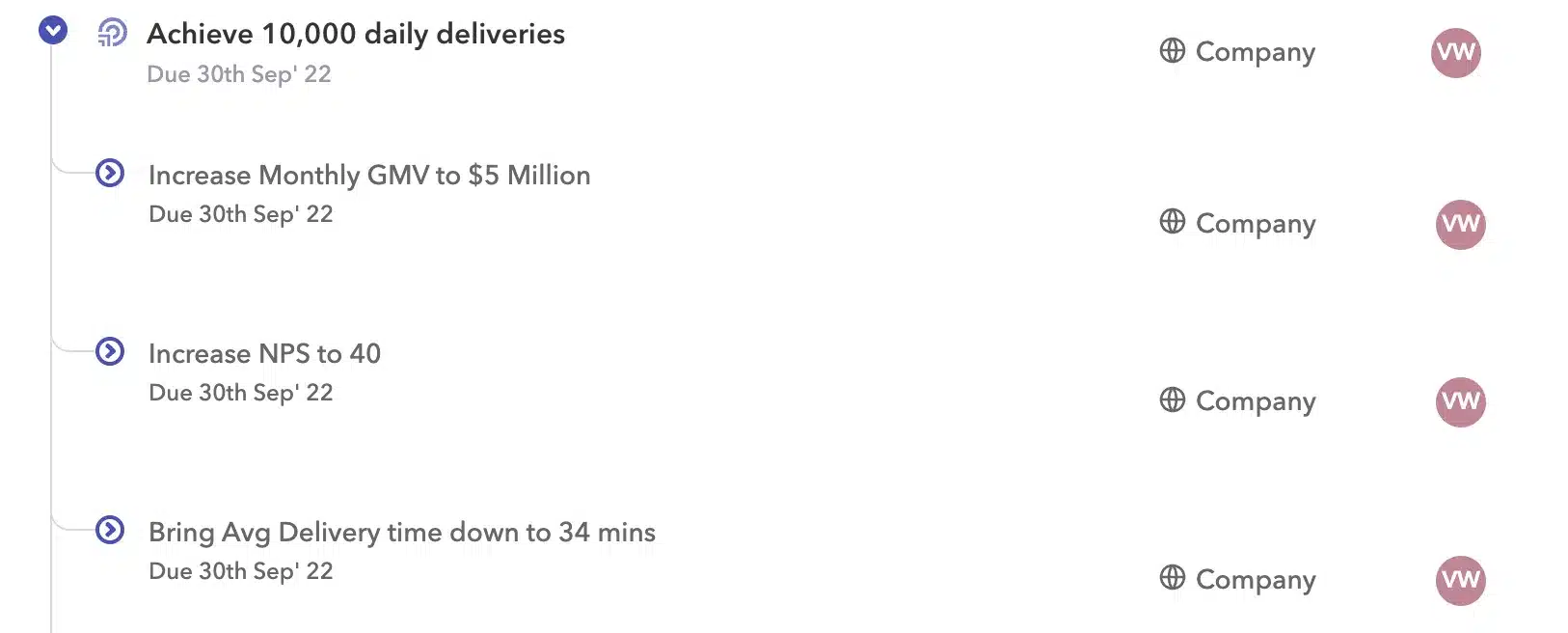Imagine you stop using OKRs today, what impact will this have on your North Star Metric?
If you don’t think it will significantly impact your business growth, you are doing OKRs wrong. That would happen at Netflix, Google, LinkedIn, and hundreds of other companies attributing their success to OKRs.
So what are you doing wrong?
The purpose of using OKRs?
The sole purpose of OKRs is faster strategy execution to achieve better business results. Everything else is a byproduct.
As companies grow, they start to see an increasing gap between strategy and execution. If you do not feel that pain today, OKRs are not for you. You will be solving a problem that doesn’t exist.
Don’t do OKRs to convince your investors, performance reviews, feedback culture, managers development, or 100 other wrong reasons.
OKRs will succeed if the purpose is right – to align teams and accelerate your business growth.
Why does execution speed slow as you grow?
We see 4 reasons why execution speed gets poorer as companies grow –
1. Lack of Focus
2. Misaligned Teams
3. Poor Visibility
4. Low Accountability
Good OKRs fix these challenges. Bad OKRs are business-as-usual metrics in OKRs clothing, barely making any dent in these challenges.
Let’s go through them one by one.
1 Focus – Do your OKRs tell everyone what matters the most?
As a CEO/ Business Head, you are clear of your top strategic priorities every quarter. The problem is your employees have no idea about it. This is the no 1 problem Good OKRs solve.
Let’s use an example of Foodie, a hypothetical food delivery company.
Bad OKRs

If your OKRs look similar, ask yourself – How different would they look, if you were not using OKRs?
Good OKRs clearly articulate your strategy and how you measure them. See the example below –
Good OKRs

When anyone sees these OKRs, they are clear on the company’s focus – SPEED.
You want to win by being the fastest food delivery, so everyone – Ops, Marketing, Product, Tech, Customer Support needs to focus on that.
Good OKRs clearly answer – What will we focus on to achieve this ambitious number (KR).
2 Alignment – Are your teams’ goals aligned to strategic priorities?
You can talk about your strategic priorities all day in standup, Weeklies, and townhalls, no one gives two hoots about it if their goals are not aligned to it.
If the company focuses on faster delivery but the Operations team’s goal is to achieve 2,000 daily deliveries, they will do everything to achieve it without caring about anything else.
Bad OKRs sometimes force your teams to focus on metrics, ignoring and sometimes hurting your strategic priorities.
Bad OKRs

Good OKRs align team goals to the company’s strategic priorities. This ensures everyone has a strong reason to work in the same direction.
Good OKRs

3 Visibility – Are your OKRs screaming about the Red-flags?
💡 The only worse thing than bad News is bad News late.
Imagine you wake up in the middle of the night and want to know the status of your goals and what’s blocking their progress? Where would you go? A dashboard, CRM or write SQL queries?
Good OKRs give you a single place to see the progress of your strategic goals and what’s blocking it.
Bad OKRs force you to call someone to know the status or look for other tools because they are just not updated.
This is why the no 1 reason OKRs fail is – Set & Forget.
Bad OKRs

Good OKRs

What can you do to ensure your OKRs are updated in real-time?
1. Integrations – Find a way to integrate your OKRs with your work-tools
2. Business Reviews – Run your Weeklies, MBR, QBR at the same place your OKRs are set and NOT on Powerpoints or Word. Powerpoints give no motivation to teams to update their OKRs.
4Accountability – Do you have a culture of Outcome or Output?
A common change companies witness as they scale is moving from a culture of outcome ( metrics, needle moving, crushing number) to a culture of outputs (projects, initiatives, tasks)
People want to complete a project or task instead of worrying about does it move the needle?
Good OKRs build an outcome-driven culture. Bad OKRs keep it the same way as before.
Bad OKRs

You can launch the 1st, 2nd and 3rd versions of iOS App, conduct NPS every day and handle 1,000 customer queries and can still be a hated food-tech App.
Bad OKRs make your team accountable for outputs and not the outcomes. Often these outputs, completed in haste, work counter-productive to your strategic priorities.
Good OKRs and features of OKR make your team accountable only to outcomes.
Good OKRs

So how are you using OKRs today? If you want to hop on a call for a free consultation or to learn more about Peoplebox, just set up a demo here.








